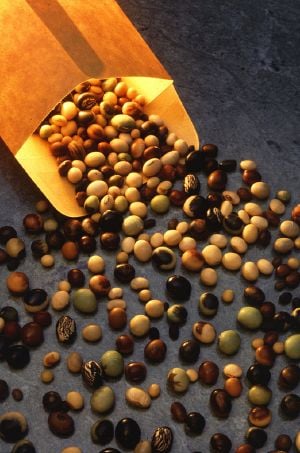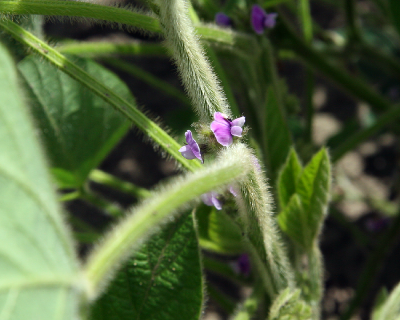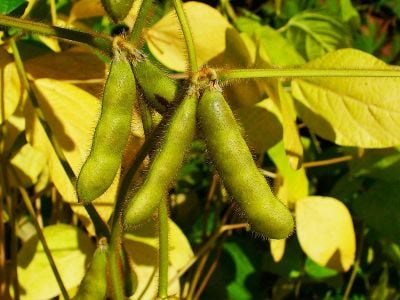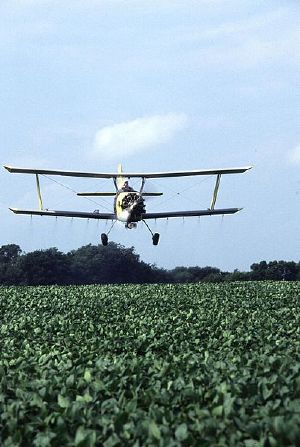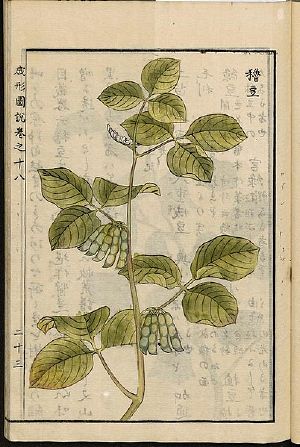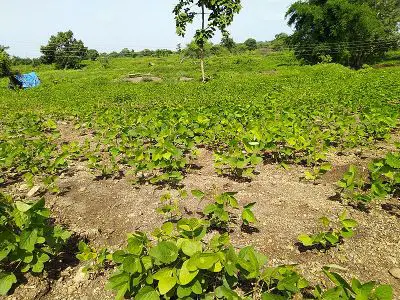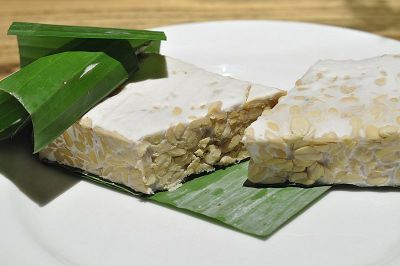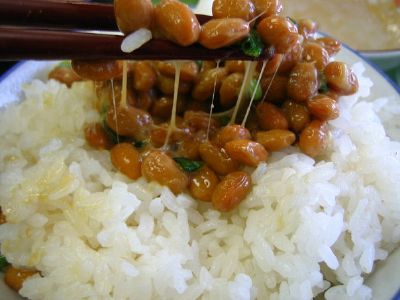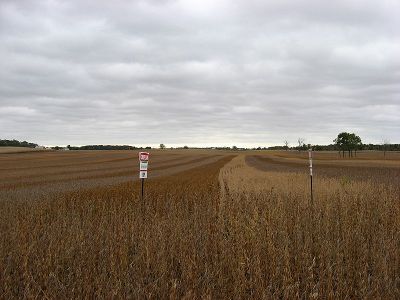Soybean
- "Soy" redirects here.
| Soybean | ||||
|---|---|---|---|---|
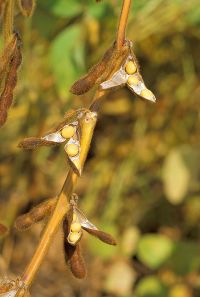 | ||||
| Scientific classification | ||||
| ||||
|
The soybean, soy bean, or soya bean (Glycine max)[1] is a species of legume native to East Asia, widely grown for its edible bean, which has numerous uses. Soybeans contain significant amounts of phytic acid, dietary minerals, and B vitamins.
Traditional unfermented food uses of soybeans include soy milk, from which tofu and tofu skin are made. Fermented soy foods include soy sauce, fermented bean paste, nattō, and tempeh. Fat-free (defatted) soybean meal is a significant and cheap source of protein for animal feed farm animals (that in turn yields animal protein for human consumption). The soybean product textured vegetable protein (TVP), is often used in meat and dairy substitutes. Soy vegetable oil, used in food and industrial applications, is another processed soybean product.
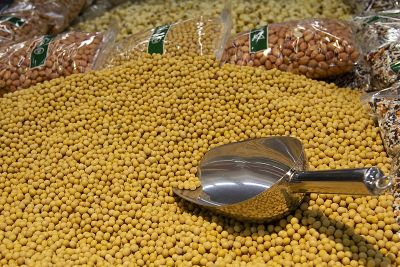
Etymology
The word "soy" originated in the Dutch soya as a corruption of the Cantonese or Japanese names for soy sauce (Chinese: 豉油; Cantonese Yale: sihyàuh (shi-yu)) (醤油 shōyu). The Chinese shi-yu is from from shi "fermented soy beans" + yu "oil." The etymology reflects Dutch presence in Japan before English and American merchants began to trade there.[2]
The name of the genus, Glycine, comes from Carl Linnaeus. When naming the genus, Linnaeus observed that one of the species within the genus had a sweet root. Based on the sweetness, the Greek word for sweet, glykós, was Latinized.[3]
Classification
The genus Glycine may be divided into two subgenera, Glycine and Soja. The subgenus Soja includes the cultivated soybean, G. max, and the wild soybean, treated either as a separate species G. soja,[4] or as the subspecies G. max subsp. soja.[5] Both cultivated and wild soybeans are annuals. The wild soybean is native to China, Japan, Korea, and Russia.[4]
The subgenus Glycine consists of at least 25 wild perennial species: for example, G. canescens and G. tomentella, both found in Australia and Papua New Guinea.[6] Perennial soybean (Neonotonia wightii) belongs to a different genus. It originated in Africa and is now a widespread pasture crop in the tropics.[7]
Like some other crops of long domestication, the relationship of the modern soybean to wild-growing species can no longer be traced with any degree of certainty.[8] It is a cultigen with a very large number of cultivars.
Description
Like most plants, soybeans grow in distinct morphological stages as they develop from seeds into fully mature plant.
Upon germination, the first stage of root growth and occurs within the first 48 hours under ideal growing conditions. The first true leaves develop as a pair of single blades. Subsequent to this first pair, mature nodes form compound leaves with three blades. Mature trifoliolate leaves, having three to four leaflets per leaf, are often between 6 and 15 cm (2.4 and 5.9 in) long and 2 and 7 cm (0.79 and 2.8 in) broad. Under ideal conditions, stem growth continues, producing new nodes every four days. Before flowering, roots can grow 2 cm (0.79 in) per day. If rhizobia are present, root nodulation begins by the time the third node appears. Nodulation typically continues for 8 weeks before the symbiotic infection process stabilizes.[9]
The final characteristics of a soybean plant are variable, with factors such as genetics, soil quality, and climate affecting its form; however, fully mature soybean plants are generally between 50 and 125 cm (20 and 50 in) in height.[10]
Flowers
Flowering is triggered by day length, often beginning once days become shorter than 12.8 hours.[9] This trait is highly variable however, with different varieties reacting differently to changing day length.[11]
Soybeans form inconspicuous, self-fertile flowers which are borne in the axil of the leaf and are white, pink or purple. Though they do not require pollination, they are attractive to bees, because they produce nectar that is high in sugar content. Depending on the soybean variety, node growth may cease once flowering begins. Strains that continue nodal development after flowering are termed "indeterminates" and are best suited to climates with longer growing seasons.[9] Often soybeans drop their leaves before the seeds are fully mature.
The fruit is a hairy pod that grows in clusters of three to five, each pod is between 3 and 8 cm (1.2 and 3.1 in) long and usually contains two to four (rarely more) seeds 5–11 mm in diameter. Soybean seeds come in a wide variety of sizes and hull colors such as black, brown, yellow, and green.[10] Variegated and bicolored seed coats are also common.
Seed resilience
The hull of the mature bean is hard, water-resistant, and protects the cotyledon and hypocotyl (or "germ") from damage. If the seed coat is cracked, the seed will not germinate. The scar, visible on the seed coat, is called the hilum (colors include black, brown, buff, gray and yellow) and at one end of the hilum is the micropyle, or small opening in the seed coat which can allow the absorption of water for sprouting.
Soybeans, containing very high levels of protein and soluble carbohydrates protecting the seed's cell viability, can undergo desiccation, yet survive and revive after water absorption.[12]
Chemical composition
Together, protein and soybean oil content account for 56 percent of dry soybeans by weight (36 percent protein and 20 percent fat). The remainder consists of 30 percent carbohydrates, 9 percent water, and 5 percent ash. Soybeans comprise approximately 8 percent seed coat or hull, 90 percent cotyledons, and 2 percent hypocotyl axis or germ.[13]
Nutrition
Raw soybean are not edible and cannot be digested. For human consumption, soybeans must be processed prior to consumption–either by cooking, roasting, or fermenting–to destroy the trypsin inhibitors (serine protease inhibitors). Raw soybeans, including the immature green form, are toxic to all monogastric animals.[14]
Soybeans are a rich source of essential nutrients, providing high contents of protein, dietary fiber, iron, manganese, phosphorus. and several B vitamins, including folate. High contents also exist for vitamin K, magnesium, zinc, and potassium. The nutritional value of soybean depends on the processing and the method of cooking: boiling, frying, roasting, baking, etc.
Protein
Most soy protein is a relatively heat-stable storage protein. This heat stability enables soy food products requiring high temperature cooking, such as tofu, soy milk, and textured vegetable protein (soy flour) to be made. Soy is a good source of protein for vegetarians and vegans or for people who want to reduce the amount of meat they eat:
Soy protein products can be good substitutes for animal products because, unlike some other beans, soy offers a 'complete' protein profile. Soybeans contain all the amino acids essential to human nutrition, which must be supplied in the diet because they cannot be synthesized by the human body. Soy protein products can replace animal-based foods—which also have complete proteins but tend to contain more fat, especially saturated fat—without requiring major adjustments elsewhere in the diet.[15]
Carbohydrates
The insoluble carbohydrates in soybeans consist of the complex polysaccharides cellulose, hemicellulose, and pectin. The majority of soybean carbohydrates can be classed as belonging to dietary fiber.
The principal soluble carbohydrates of mature soybeans are the disaccharide sucrose, the trisaccharide raffinose, and the tetrasaccharide stachyose. While the oligosaccharides raffinose and stachyose protect the viability of the soybean seed from desiccation they are not digestible sugars, so contribute to flatulence and abdominal discomfort in humans and other monogastric animals. Since soluble soy carbohydrates are found in the whey and are broken down during fermentation, soy concentrate, soy protein isolates, tofu, soy sauce, and sprouted soybeans are digestible.
Fats
Raw soybeans are 20 percent fat, including saturated fat, monounsaturated fat, and polyunsaturated fat, mainly as linoleic acid.
Cultivation
Soybean cultivation is successful in climates with hot summers, with optimum growing conditions in mean temperatures of 20 °C (68 °F) to 30 °C (86 °F); temperatures of below 20 °C (68 °F) and over 40 °C (104 °F) stunt growth significantly. They can grow in a wide range of soils, with optimum growth in moist alluvial soils with good organic content.
Soybeans, like most legumes, perform nitrogen fixation by establishing a symbiotic relationship with the bacterium Bradyrhizobium japonicum (syn. Rhizobium japonicum; Jordan 1982). This ability to fix nitrogen allows farmers to reduce nitrogen fertilizer use and increase yields when growing other crops in rotation with soy.
Pests
Soybean plants are vulnerable to a wide range of bacterial diseases, fungal diseases, viral diseases, and parasites.
The primary bacterial diseases that affect the soybean plant include bacterial blight, bacterial pustule, stem rot, and downy mildew.[16]
Soybean cyst nematode (SCN), a plant-parasitic roundworm, is the most yield limiting soybean pest in the U.S.[17]
The corn earworm moth and bollworm (Helicoverpa zea) is a common and destructive pest of soybean growth in Virginia.[18]
Soybeans are consumed by whitetail deer which may damage soybean plants through feeding, trampling and bedding, reducing crop yields. Groundhogs are also a common pest in soybean fields, living in burrows underground and feeding nearby. One den of groundhogs can consume a tenth to a quarter of an acre of soybeans.
Cultivars
Modern crop cultivars generally reach a height of around 1 m (3 ft), and take 80–120 days from sowing to harvesting.
Disease resistant varieties are available. The vast majority of cultivars in the US have soybean cyst nematode resistance (SCN resistance).
Cultivation History
Soybeans were a crucial crop in East Asia long before written records began.[19] They were first cultivated in North America in the eighteenth century, a little later in Europe and South America. However, for a long time the crop was grown primarily for animal feed and industrial products with little used for human consumption. By the twenty-first century, however, with increased interest in its protein value, especially as a substitute meat product for vegetarians, soybeans became an important food source.
East Asia
The cultivation of soybeans is known to have taken place in the eastern half of northern China by 2000 B.C.E., but is almost certainly much older.[20] According to the ancient Chinese myth, in 2853 B.C.E., the legendary Emperor Shennong of China proclaimed that five plants were sacred: soybeans, rice, wheat, barley, and millet. Thus he is called as "The Emperor of Five Grains."[21]
Some scholars suggest that soybean originated in China and was domesticated about 3500 B.C.E.[22] Recent research, however, indicates that seeding of wild forms started earlier. The earliest documented evidence for the use of Glycine of any kind comes from charred plant remains of wild soybean recovered from Jiahu in Henan province China, a Neolithic site occupied between 9000 and 7800 calendar years ago.[23] An abundance of archeological charred soybean specimens have been found centered around this region.
The oldest preserved soybeans resembling modern varieties in size and shape were found in archaeological sites in Korea. Radiocarbon dating of soybean samples recovered through flotation during excavations at the Early Mumun period site in Korea indicated soybean was cultivated as a food crop in around 1000–900 B.C.E.[24]
Soybeans from the Jōmon period in Japan from 3000 B.C.E. are also significantly larger than wild varieties.[23] The earliest Japanese textual reference to the soybean is in the classic Kojiki (Records of Ancient Matters), which was completed in 712 C.E.
Soybeans became an important crop by the Zhou dynasty (c. 1046–256 B.C.E.) in China. However, the details of where, when, and under what circumstances soybean developed a close relationship with people are poorly understood. Soybean was unknown in South China before the Han period.[23] From about the first century C.E. to the Age of Discovery (fifteenth-sixteenth centuries), soybeans were introduced into across South and Southeast Asia. This spread was due to the establishment of sea and land trade routes.
Southeast Asia
By the thirteenth century, the soybean had arrived and cultivated in Indonesia; it probably arrived much earlier however, carried by traders or merchants from Southern China.
The earliest known reference to it as "tempeh" appeared in 1815 in the Serat Centhini manuscript.[25] The development of tempeh fermented soybean cake probably took place earlier, circa seventeenth century in Java.
Indian subcontinent
The soybean probably arrived from southern China, moving southwest into northern parts of Indian subcontinent. By the 1600s, soy sauce spread from southern Japan across the region through the Dutch East India Company.[26]
North America
Soybeans were first introduced to North America from China in 1765, by Samuel Bowen, a former East India Company sailor who had visited China in conjunction with James Flint.[27] The first soybeans were grown near Savannah, Georgia, and were made into soy sauce for sale in England.[28]
William Morse is considered the "father" of modern soybean agriculture in America. He and Charles Piper took what was an unknown Oriental peasant crop in 1910 and transformed it into a "golden bean" for America, becoming one of America's largest farm crops and its most nutritious.[29]
Prior to the 1920s in the US, the soybean was mainly a forage crop, a source of oil, meal (for feed) and industrial products, with very little used as food. During the Great Depression, the drought-stricken (Dust Bowl) regions of the United States were able to use soy to regenerate their soil because of its nitrogen-fixing properties. Farms were increasing production to meet with government demands, and Henry Ford became a promoter of soybeans.[30] Soybean oil was used by Ford in paint for the automobiles,[31] as well as a fluid for shock absorbers.
During World War II, soybeans became important chiefly as substitutes for other protein foods and as a source of edible oil.
Prior to the 1970s, Asian-Americans and Seventh-Day Adventists were essentially the only users of soy foods in the United States:
The soy foods movement began in small pockets of the counterculture, notably the Tennessee commune named simply The Farm, but by the mid-1970s a vegetarian revival helped it gain momentum and even popular awareness through books such as The Book of Tofu.[32]
Although practically unseen in 1900, by 2000 soybean plantings covered more than 70 million acres, second only to corn, and had become the nation’s largest cash crop.[32]
Western Europe
The Portuguese and Spanish were familiar with soybeans and soybean product through their trade with Far East since at least the seventeenth century. However, it was not until the late nineteenth century that the first attempt to cultivate soybeans in the Iberian peninsula was undertaken. In 1880, the soybean was first cultivated in Portugal in the Botanical Gardens at Coimbra.[33] In the early twentieth century the first attempts at Soybean cultivation in Spain were made by the Count of San Bernardo, who cultivated soybeans on his estates at Almillo (in southwest Spain) about 48 miles east-northeast of Seville.[33]
The soybean was first cultivated in France in the eighteenth century. In the early twentieth century Li Yu-ying, who had been living in France for several years, went back to China and returned with five workers and a large supply of Chinese soybeans and coagulant. Hhe and his engineers designed equipment to transform soybeans into soymilk and then tofu. He built a large factory where the first commercial soyfoods in France were made.[34]
Soybeans were grown in Italy in botanical gardens in the eighteenth century. However, only since the late 1950s was there serious interest in soybeans, soybean oil or meal, or traditional Asian soyfoods in Italy.[35] By 1939, soybeans were cultivated in Greece.[36]
Soybeans began to be cultivated in Switzerland and Austria (then part of the Austro-Hungarian Empire) in the late nineteenth century. They were first cultivated in Switzerland in 1861. In 1873, Professor Friedrich J. Haberlandt first became interested in soybeans when he obtained the seeds of 19 soybean varieties at the Vienna World Exposition (Wiener Weltausstellung). He cultivated these seeds in Vienna, and soon began to distribute them throughout Central and Western Europe.[37]
South America
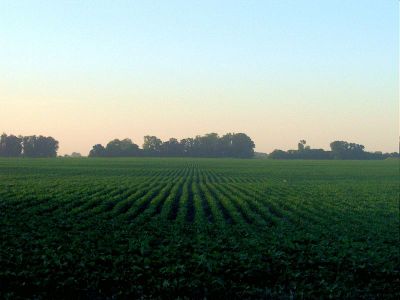
Soybeans were first cultivated in South America in the late nineteenth to early twentieth century. They were cultivated in French Guiana in 1893; by the 1940s and 1950s Argentina and Brazil were producing major soybean crops.[38]
In June 1973, when soybean futures markets mistakenly portended a major shortage, the Richard Nixon administration imposed an embargo on soybean exports. It lasted only a week, but Japanese buyers felt that they could not rely on U.S. supplies, and the rival Brazilian soybean industry in the Cerrado region came into existence.[39][30]
An unfortunate consequence of the growth of soybean production in South America is deforestation. In spite of the Amazon "Soy Moratorium," soy production continues to play a significant role in deforestation when its indirect impacts are taken into account, as land used to grow soy continues to increase. This land either comes from pasture land (which increasingly supplants forested areas), or areas outside the Amazon not covered by the moratorium, such as the Cerrado region.[40]
Uses

Tofu,[41] soy milk, and soy sauce are among the top edible commodities made using soybeans. Soybean oil is one of the most widely consumed cooking oils.
Soybean oil
To extract soybean oil from seed, the soybeans are cracked, adjusted for moisture content, rolled into flakes, and solvent-extracted with commercial hexane.[42] The oil is then refined, blended for different applications, and sometimes hydrogenated. Soybean oils, both liquid and partially hydrogenated, are exported abroad, sold as "vegetable oil," or end up in a wide variety of processed foods.
Soybean meal
Soybean meal, or soymeal, is the material remaining after solvent extraction of oil from soybean flakes; it has a 50 percent soy protein content. The meal is 'toasted' (a misnomer because the heat treatment is with moist steam) and ground in a hammer mill. Soybean meal is the most important protein source used to feed farm animals, with 97 percent of soybean meal production globally is used as livestock feed.[43]
Livestock feed
One of the major uses of soybeans globally is as livestock feed, predominantly in the form of soybean meal.[43] The soybean hulls, which mainly consist of the outer coats of the beans removed before oil extraction, can also be fed to livestock, as well as whole soybean seeds after processing.
Food for human consumption
In addition to their use in livestock feed, soybean products are widely used for human consumption. Common soybean products include soy sauce, soy milk, tofu, soy meal, soy flour, textured vegetable protein (TVP), soy curls, tempeh, soy lecithin, and soybean oil. Soybeans may also be eaten with minimal processing, for example, in the Japanese food edamame (枝豆 edamame), in which immature soybeans are boiled whole in their pods and served with salt.
In China, Japan, Vietnam, and Korea, soybean and soybean products are a standard part of the diet. Tofu (豆腐 dòufu) is thought to have originated in China, along with soy sauce and several varieties of soybean paste used as seasonings. In China, whole dried soybeans are sold in supermarkets and used to cook various dishes, usually after rehydration by soaking in water; they find their use in soup or as a savory dish.
Japanese foods made from soy include miso (味噌), nattō (納豆), kinako (黄粉), and edamame (枝豆), as well as products made with tofu, such as atsuage and aburaage.
In Korean cuisine, soybean sprouts (콩나물 kongnamul) are used in a variety of dishes, and soybeans are the base ingredient in doenjang, cheonggukjang, and ganjang.
In Vietnam, soybeans are used to make soybean paste (tương) in the North with the most popular products are tương Bần, tương Nam Đàn, tương Cự Đà as a garnish for phở and gỏi cuốn dishes, as well as tofu (đậu hũ or đậu phụ or tàu hũ), soy sauce (nước tương), soy milk (nước đậu in the North or sữa đậu nành in the South), and đậu hũ nước đường (tofu sweet soup).
Flour
Soy flour refers to soybeans ground finely enough to pass through a 100-mesh or smaller screen where special care was taken during desolventizing (not toasted) to minimize denaturation of the protein to retain a high protein dispersibility index, for uses such as food extrusion of textured vegetable protein. It is the starting material for soy concentrate and protein isolate production.
Soy flour can also be made by roasting the soybean, removing the coat (hull), and grinding it into flour. Alternatively, raw soy flour omits the roasting step. Soy flour is manufactured with different fat levels.
- Defatted soy flour is obtained from solvent extracted flakes and contains less than 1 percent oil.
- Natural or full-fat soy flour is made from unextracted, dehulled beans and contains 18-20 percent oil. Its high oil content requires the use of a specialized Alpine Fine Impact Mill to grind rather than the usual hammer mill. Full-fat soy flour has a lower protein concentration than defatted flour. Extruded full-fat soy flour, ground in an Alpine mill, can replace/extend eggs in baking and cooking.
- Low-fat soy flour is made by adding some oil back into defatted soy flour.
- High-fat soy flour can also be produced by adding back soybean oil to defatted flour, usually at 15 percent.[44]
Soy lecithin can be added to soy flour to make lecithinated soy flour. It increases dispersibility and gives it emulsifying properties.
Soy flour has higher levels of protein, thiamine, riboflavin, phosphorus, calcium, and iron than wheat flour, and does not contain gluten. As a result, yeast-raised breads made with soy flour are dense in texture. Among many uses, soy flour thickens sauces, prevents staling in baked food, and reduces oil absorption during frying. Baking food with soy flour gives it tenderness, moistness, a rich color, and a fine texture.
Soy grits are similar to soy flour, except the soybeans have been toasted and cracked into coarse pieces.
Soy-based infant formula
Soy-based infant formula (SBIF) is sometimes given to infants who are not being strictly breastfed; it can be useful for infants who are either allergic to pasteurized cow milk proteins or who are being fed a vegan diet. It is sold in powdered, ready-to-feed, and concentrated liquid forms.
Meat and dairy alternatives
Soybeans can be processed to produce a texture and appearance similar to many other foods. For example, soybeans are the primary ingredient in many dairy product substitutes (such as soy milk, margarine, soy ice cream, soy yogurt, soy cheese, and soy cream cheese) and meat alternatives (such as veggie burgers). These substitutes are readily available in most supermarkets. Soy milk does not naturally contain significant amounts of digestible calcium, although many manufacturers of soy milk sell calcium-enriched products.
Soy products also are used as a low-cost substitute for meat and poultry products.[45] Vitamin and mineral fortification can be used to make soy products nutritionally equivalent to animal protein; the protein quality is already roughly equivalent. The soy-based meat substitute textured vegetable protein has been used for more than 50 years as a way of inexpensively extending ground beef without reducing its nutritional value.[46]
Sweetened soybean
Sweet-boiled beans are popular in Japan and Korea, and the sweet-boiled soybeans are called Daizu no Nimame (煮豆) in Japan and Kongjorim (콩조림) in Korea. Sweet-boiled beans are even used in sweetened buns, especially in Mame Pan (豆パン).
The boiled and pasted edamame, called Zunda (ずんだ), is used as one of the Sweet bean pastes in Japanese confections.
Coffee substitute
Roasted and ground soybeans can be a caffeine-free substitute for coffee. After the soybeans are roasted and ground, they look similar to regular coffee beans or can be used as a powder similar to instant coffee, with the aroma and flavor of roasted soybeans.[19]
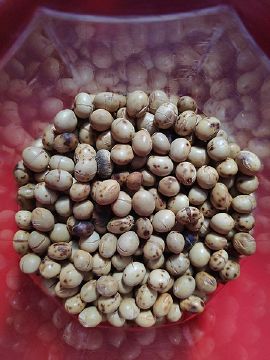
Other products
Soybeans with black hulls are used in Chinese fermented black beans, douchi, not to be confused with black turtle beans.
Soybeans have also been used since 2001 as fermenting stock in the manufacture of a brand of vodka.[47]
Soybeans are also used in industrial products, including oils, soap, cosmetics, resins, plastics, inks, crayons, solvents, and clothing. Soybean oil is the primary source of biodiesel in the United States.
Health effects
Soybeans contain plant compounds that may have beneficial health effects, for example, that they reduce risk of coronary heart disease and breast and prostate cancer.[48] However, soy products may also lead to allergic reactions in some people.
Reducing risk of cancer
According to the American Cancer Society:
There is some evidence from human and lab studies that consuming traditional soy foods such as tofu may lower the risk of breast and prostate cancer, but overall the evidence is too limited to draw firm conclusions.[49]
Several studies looking at women in Asian countries have found that diets high in soy products might lower breast cancer risk. But this link has not been as clear in studies looking at women in Western countries. This might be because Asian women generally eat more soy products (and start at an earlier age) than Western women.[50]
However, there are no data to support the use of soy dietary supplements.
Cardiovascular health
There have been claims that soy protects against heart disease, for example by the Food and Drug Administration in 2000; however, the results of many recent studies have been inconclusive. The American Heart Association Nutrition Committee's 2006 recommendations regarding soy concluded:
Evidence of a direct cardiovascular health benefit from consuming soy protein products instead of dairy or other proteins or of isoflavone supplements is minimal ... Nevertheless, consumption of soy protein–rich foods may indirectly reduce CVD risk if they replace animal and dairy products that contain saturated fat and cholesterol.[51]
Soy allergy
In young children, soy is one of the most common food allergens. It is a hypersensitivity to ingesting compounds in soy, causing an overreaction of the immune system, typically with physical symptoms such as gastrointestinal discomfort, respiratory distress, or a skin reaction. Rarely, a soy allergy will cause anaphylaxis, a potentially life-threatening reaction that impairs breathing, causes a sudden drop in blood pressure, and can send the body into shock.
Typically, allergic reactions first appear in infants and young children under three years of age, and many outgrow the allergy during childhood. As with other food allergies, the best way to manage a soy allergy is to avoid consuming products that contain soy. Soy is one of the eight allergens that fall under the labeling requirements of the Food Allergen Labeling and Consumer Protection Act of 2004.[52]
Genetic modification
Soybeans are one of the "biotech food" crops that have been genetically modified, and genetically modified soybeans are being used in an increasing number of products. In 1995, Monsanto company introduced glyphosate-tolerant soybeans that have been genetically modified to be resistant to Monsanto's glyphosate herbicides.[53]
As with other glyphosate-tolerant crops, concern has been expressed over damage to biodiversity.[14]
The widespread use of such types of GM soybeans in the Americas has caused problems with exports to some regions. GM crops require extensive certification before they can be legally imported into the European Union, where there is considerable supplier and consumer reluctance to use GM products for consumer or animal use.[54]
Notes
- ↑ Glycine max Multilingual Multiscript Plant Name Database. Retrieved January 23, 2024.
- ↑ soy (n.) Etymology Online. Retrieved January 23, 2024.
- ↑ T. Hymowitz and C.A. Newell, Taxonomy of the genus Glycine, domestication and uses of soybeans Economic Botany 35(3) (July 1981):272–288. Retrieved January 23, 2024.
- ↑ 4.0 4.1 Ram J. Singh (ed.), Genetic Resources, Chromosome Engineering, and Crop Improvement: Oilseed Crops, Volume 4 (CRC Press, 2006, ISBN 978-0849336393).
- ↑ H. Ohashi, Glycine max subsp. soja (Siebold & Zucc.) Plants of the World Online, Royal Botanic Gardens, Kew. Retrieved January 24, 2024.
- ↑ Theresa K. Herman, Jaeyeong Han, Ram J. Singh, Leslie L. Domier, and Glen L. Hartman, Evaluation of Wild Perennial Glycine Species and Crosses For Resistance to Phakopsora Plant Breeding 139(5) (October 2020):923-931. Retrieved January 24, 2024.
- ↑ Perennial soybean (Neonotonia wightii) Feedipedia. Retrieved January 24, 2024.
- ↑ Hossain Uddin Shekhar, Zakir Hossain Howlader, and Yearul Kabir (eds.), Exploring the Nutrition and Health Benefits of Functional Foods (Medical Information Science Reference, 2016, ISBN 978-1522505914).
- ↑ 9.0 9.1 9.2 Larry C. Purcell, Montserrat Salmeron, and Lanny Ashlock, Soybean Growth and Development Arkansas Soybean Production Handbook - MP197. Retrieved January 25, 2024.
- ↑ 10.0 10.1 y W. Morrison, Soybean Facts Arkansas Soybean Production Handbook – MP197. Retrieved January 25, 2024.
- ↑ William Shurtleff and Akiko Aoyagi, History of Soybeans and Soyfoods in Sweden, Norway, Denmark and Finland (1735–2015) (Soyinfo Center, 2015). Retrieved January 25, 2024.
- ↑ Sheila A. Blackman, Ralph L. Obendorf, and A. Carl Leopold, Maturation Proteins and Sugars in Desiccation Tolerance of Developing Soybean Seeds Plant Physiology100(1) (1992): 225–230. Retrieved January 25, 2024.
- ↑ Colin Wrigley, Harold Corke, and Charles E. Walker (eds.), Encyclopedia of Grain Science (Academic Press, 2004, ISBN 978-0127654904).
- ↑ 14.0 14.1 KeShun Liu, Soybeans: Chemistry, Technology, and Utilization (Springer, 2012, ISBN 978-1461357117).
- ↑ M. Saljoughian, Focus on Phytoestrogens US Pharmacist 32(12) (2007):27-32. Retrieved January 25, 2024.
- ↑ Amelia Eldridge, Soybean – How to grow and care Garden And Me. Retrieved January 25, 2024.
- ↑ Dylan Mangel, Soybean Cyst Nematode University of Nebraska–Lincoln. Retrieved January 25, 2024.
- ↑ Ames Herbert, Cathy Hull, and Eric Day, Corn Earworm Biology and Management in Soybeans Virginia Cooperative Extension. Retrieved January 25, 2024.
- ↑ 19.0 19.1 William Shurtleff and Akiko Aoyagi, History of Whole Dry Soybeans, Used as Beans, or Ground, Mashed or Flaked (240 B.C.E. to 2013) (Soyinfo Center, 2013). Retrieved January 26, 2024.
- ↑ Denis J. Murphy, People, Plants and Genes: The Story of Crops and Humanity (Oxford University Press, 2007, ISBN 978-0199207145)
- ↑ Tel Asiado, Shennong Edible Wild Food. Retrieved January 26, 2024.
- ↑ Mohammad Rafiq Siddiqi, Tylenchida: Parasites of Plants and Insects (CABI, 2000, ISBN 978-0851992020).
- ↑ 23.0 23.1 23.2 Gyoung-Ah Lee, Gary W. Crawford, Li Liu, Yuka Sasaki, and Xuexiang Chen, Archaeological Soybean (Glycine max) in East Asia: Does Size Matter? PLOS ONE 6(11) (November 4, 2011): e26720. Retrieved January 25, 2024.
- ↑ Miriam T. Stark (ed.), Archaeology of Asia (Wiley-Blackwell, 2005, ISBN 978-1405102131).
- ↑ William Shurtleff and Akiko Aoyagi, The Book of Tempeh (Ten Speed Press, 2001, ISBN 978-1580083355).
- ↑ William Shurtleff and Akiko Aoyagi, History of Soybeans and Soyfoods in South Asia / Indian Subcontinent (1656–2010) (Soyinfo Center, 2010). Retrieved January 26, 2024.
- ↑ Joyce E. Chaplin, An Anxious Pursuit: Agricultural Innovation and Modernity in the Lower South, 1730–1815 (University of North Carolina Press, 1996, ISBN 978-0807846131).
- ↑ Aaron Brachfeld and Mary Choate, Eat Your Food! Gastronomical Glory from Garden to Gut (Coastalfields Press, 2007).
- ↑ William Shurtleff and Akiko Aoyagi, William J. Morse and Charles V. Piper: Work with Soy (Soyinfo Center, 2004). Retrieved January 26, 2024.
- ↑ 30.0 30.1 Justin Fox, How Soybeans Became Ubiquitous Bloomberg (December 7, 2019). Retrieved January 26, 2024.
- ↑ Joe Schwarcz, The Fly in the Ointment: 70 Fascinating Commentaries on the Science of Everyday Life (ECW Press, 2004, ISBN 978-1550226218).
- ↑ 32.0 32.1 Matthew Roth, Magic Bean: The Rise of Soy in America (Lawrence, KS: University Press of Kansas, 2018, ISBN 978-0700626335).
- ↑ 33.0 33.1 William Shurtleff and Akiko Aoyagi, History of Soybeans and Soyfoods in Spain and Portugal (1603-2015) (Soyinfo Center, 2015). Retrieved January 27, 2024.
- ↑ William Shurtleff and Akiko Aoyagi, History of Soybeans and Soyfood in France (1665–2015) (Soyinfo Center, 2015). Retrieved January 27, 2024.
- ↑ William Shurtleff and Akiko Aoyagi, History of Soybeans and Soyfoods in Italy (1597-2015) (Soyinfo Center, 2015). Retrieved January 27, 2024.
- ↑ William Shurtleff and Akiko Aoyagi, History of Soybeans and Soyfoods in Greece, the European Union and Small Western European Countries (1939–2015) (Soyinfo Center, 2015). Retrieved January 27, 2024.
- ↑ William Shurtleff and Akiko Aoyagi, History of Soybeans and Soyfoods in Austria and Switzerland (1781–2015) (Soyinfo Center, 2015). Retrieved January 27, 2024.
- ↑ William Shurtleff and Akiko Aoyagi, History of Soybeans and Soyfoods in South America (1882-2009) (Soyinfo Center, 2009). Retrieved January 27, 2024.
- ↑ Daryll E. Ray, Nothing intensifies food security concerns like food unavailability Policy Pennings Agricultural Policy Analysis Center. Retrieved January 27, 2024.
- ↑ Hannah Ritchie, Drivers of Deforestation Our World in Data (February 4, 2021). Retrieved January 27, 2024.
- ↑ William Shurtleff and Akiko Aoyagi, The Book of Tofu (Ballantine Books, 1987, ISBN 978-0345351814).
- ↑ John P. Friedrich and Gary R. List, Characterization of soybean oil extracted by supercritical carbon dioxide and hexane Journal of Agricultural and Food Chemistry 30(1) (1982):192–193. Retrieved January 27, 2024.
- ↑ 43.0 43.1 Livestock's long shadow: environmental issues and options Food and Agriculture Organization of the United Nations (Rome, 2006). Retrieved January 27, 2024.
- ↑ Zeki Berk, Technology of production of edible flours and protein products from soybeans Food and Agriculture Organization of the United Nations (Rome, 1992). Retrieved January 27, 2024.
- ↑ Joseph G. Endres, Soy Protein Products (Champaign-Urbana, IL: AOCS Publishing, 2001, ISBN 978-1893997271).
- ↑ Mian N. Riaz, Soy Applications in Food (Boca Raton, FL: CRC Press, 2005, ISBN 978-0849329814).
- ↑ How Vodka is Made Martini Muse. Retrieved January 27, 2024.
- ↑ Mark Messina, Soy and Health Update: Evaluation of the Clinical and Epidemiologic Literature Nutrients 8(12) (2016):754. Retrieved January 27, 2024.
- ↑ Common Questions About Diet, Activity, and Cancer Risk: Soy and soy products American Cancer Society. Retrieved January 28. 2024.
- ↑ Factors with Unclear Effects on Breast Cancer Risk American Cancer Society. Retrieved January 28, 2024.
- ↑ Diet and Lifestyle Recommendations Revision 2006: A Scientific Statement From the American Heart Association Nutrition Committee Circulation 114(1) (July 4, 2006). Retrieved January 28, 2024.
- ↑ Soy The American College of Allergy, Asthma & Immunology (ACAAI). Retrieved January 28, 2024.
- ↑ S.R. Padgette et al., Development, Identification, and Characterization of a Glyphosate-Tolerant Soybean Line Crop Science 35(5) (September–October 1995):1451-1461
- ↑ Fact Sheet: Questions and Answers on EU's policies on GMOs European Commission, April 22, 2015. Retrieved January 28, 2024.
ReferencesISBN links support NWE through referral fees
- Brachfeld, Aaron, and Mary Choate. Eat Your Food! Gastronomical Glory from Garden to Gut. Coastalfields Press, 2007.
- Chaplin, Joyce E. An Anxious Pursuit: Agricultural Innovation and Modernity in the Lower South, 1730–1815. University of North Carolina Press, 1996. ISBN 978-0807846131
- Endres, Joseph G. Soy Protein Products. Champaign-Urbana, IL: AOCS Publishing, 2001. ISBN 978-1893997271
- Liu, KeShun. Soybeans: Chemistry, Technology, and Utilization. Springer, 2012. ISBN 978-1461357117
- Murphy, Denis J. People, Plants and Genes: The Story of Crops and Humanity. Oxford University Press, 2007. ISBN 978-0199207145
- Riaz, Mian N. Soy Applications in Food. Boca Raton, FL: CRC Press, 2005. ISBN 978-0849329814
- Roth, Matthew. Magic Bean: The Rise of Soy in America. Lawrence, KS: University Press of Kansas, 2018. ISBN 978-0700626335
- Schwarcz, Joe. The Fly in the Ointment: 70 Fascinating Commentaries on the Science of Everyday Life. ECW Press, 2004., ISBN 978-1550226218
- Shekhar, Hossain Uddin, Zakir Hossain Howlader, and Yearul Kabir (eds.). Exploring the Nutrition and Health Benefits of Functional Foods. Medical Information Science Reference, 2016. ISBN 978-1522505914
- Shurtleff, William, and Akiko Aoyagi. The Book of Tofu. Ballantine Books, 1987 (original 1978). ISBN 978-0345351814
- Shurtleff, William, and Akiko Aoyagi. The Book of Tempeh. Ten Speed Press, 2001. ISBN 978-1580083355
- Siddiqi, Mohammad Rafiq. Tylenchida: Parasites of Plants and Insects. CABI, 2000. ISBN 978-0851992020
- Singh, Ram J. (ed.). Genetic Resources, Chromosome Engineering, and Crop Improvement: Oilseed Crops, Volume 4. CRC Press, 2006. ISBN 978-0849336393
- Stark, Miriam T. (ed.). Archaeology of Asia. Wiley-Blackwell, 2005. ISBN 978-1405102131
- Wrigley, Colin, Harold Corke, and Charles E. Walker (eds.). Encyclopedia of Grain Science. Academic Press, 2004. ISBN 978-0127654904
External links
All links retrieved January 28, 2024.
- Uses of Soybeans North Carolina Soybean Producers Association
- What to know about soy Medical News Today
- Soybeans 101: Nutrition Facts and Health Effects Healthline
- Soybeans and Oil Crops US Department of Agriculture
- Soyinfo Center
Credits
New World Encyclopedia writers and editors rewrote and completed the Wikipedia article in accordance with New World Encyclopedia standards. This article abides by terms of the Creative Commons CC-by-sa 3.0 License (CC-by-sa), which may be used and disseminated with proper attribution. Credit is due under the terms of this license that can reference both the New World Encyclopedia contributors and the selfless volunteer contributors of the Wikimedia Foundation. To cite this article click here for a list of acceptable citing formats.The history of earlier contributions by wikipedians is accessible to researchers here:
The history of this article since it was imported to New World Encyclopedia:
Note: Some restrictions may apply to use of individual images which are separately licensed.
